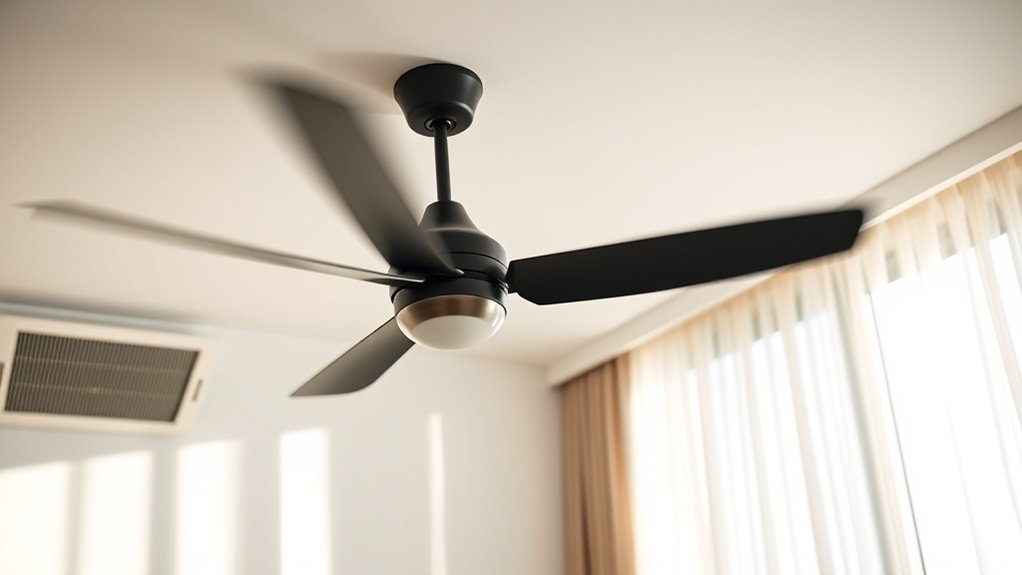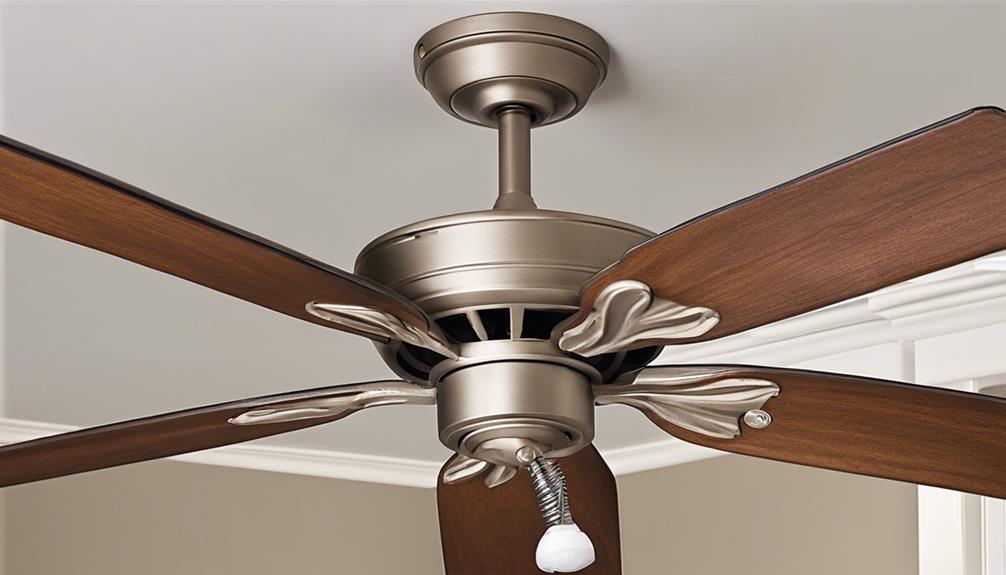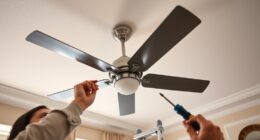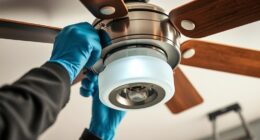To improve indoor air circulation, use ceiling fans wisely by turning them on only when needed and adjusting their direction seasonally—counterclockwise in summer and reverse in winter. Properly position vents and fans near doorways to promote cross-ventilation, and open windows during mild weather to let fresh air in. Avoid blocking vents or overusing fans, which can hamper airflow. Keep exploring these strategies to create a healthier, more comfortable home environment.
Key Takeaways
- Use ceiling fans strategically, turning them off when not needed to prevent stagnant air and conserve energy.
- Position vents and fans to promote cross-ventilation and avoid dead zones, adjusting seasonally for optimal airflow.
- Combine natural ventilation with exhaust fans and air purifiers for comprehensive indoor air quality improvement.
- Implement smart ventilation systems with sensors to automatically manage airflow based on real-time air quality data.
- Regularly check and seal leaks before extreme weather to ensure consistent, effective indoor air circulation year-round.
The Hidden Power of Ceiling Fans in Airflow Optimization

Ceiling fans are often overlooked when it comes to optimizing indoor air circulation, but they hold powerful potential. Their effectiveness hinges on airflow dynamics, which determine how air moves throughout a room. The key lies in fan blade design; blades shaped and angled correctly can substantially improve airflow efficiency. Well-designed blades create a smooth, steady circulation, pushing air down or pulling it up to promote even temperature distribution. The rotation speed and blade pitch also influence how well the fan moves air, helping to reduce stagnant spots and improve overall air quality. By understanding these aspects, you can choose and position your ceiling fan to maximize airflow, making your indoor environment more comfortable and energy-efficient. Additionally, advanced blade design can further enhance airflow performance, optimizing circulation for better indoor air quality.
Proper Ventilation Techniques for a Healthier Home

Proper ventilation is essential for maintaining a healthy indoor environment, as it helps remove pollutants, excess moisture, and odors. To achieve this, prioritize regular air filter maintenance to ensure your HVAC system effectively traps airborne particles. Controlling humidity is equally important; too much moisture fosters mold growth, while too little can cause dryness. Use exhaust fans in kitchens and bathrooms to vent humid air outside. Keep windows open when weather permits to promote cross-ventilation, invigorating indoor air naturally. Additionally, installing vents or air purifiers can improve air quality. Incorporating automation in airflow management can optimize ventilation efficiency and maintain consistent indoor air quality.
How to Position Fans and Vents for Maximum Effectiveness
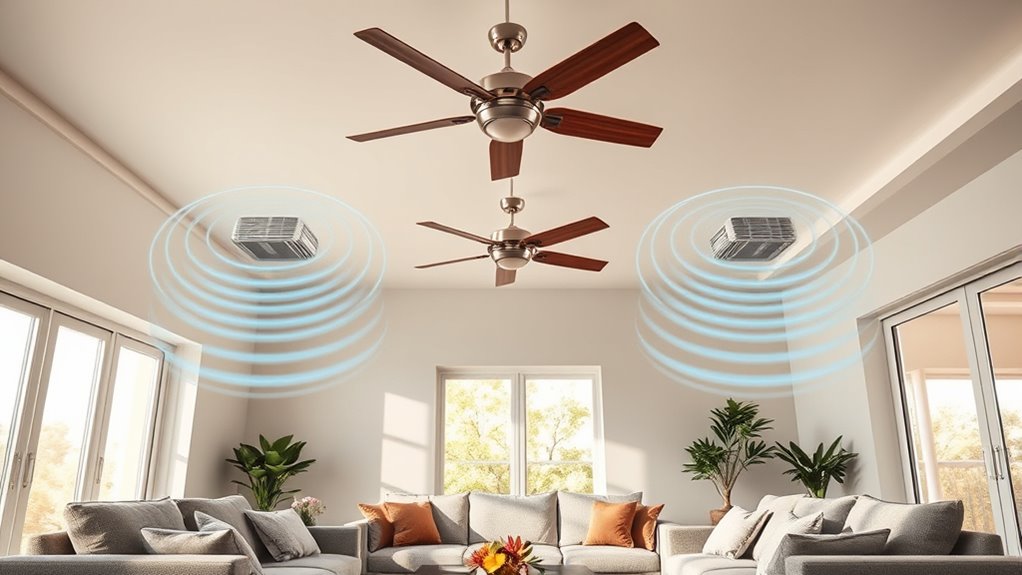
Positioning fans and vents correctly can considerably boost indoor air circulation, making your space feel fresher and more comfortable. To optimize room airflow, place fans where they can move air across the entire room, such as near doorways or open spaces. Ceiling fans should be installed to rotate counterclockwise in summer, pushing air downward, creating a breeze that cools the room. For vents, ensure they’re positioned to promote even air distribution, avoiding dead zones or stagnant spots. Use fans to direct airflow toward vents or open areas to enhance circulation. Avoid blocking vents with furniture, and keep fans at a height that maximizes their reach. Proper fan placement and strategic vent positioning work together to improve room airflow, reducing stale air and maintaining a more balanced indoor environment. Additionally, selecting the right air circulation equipment can further enhance airflow efficiency throughout the space.
Understanding the Role of Cross-Ventilation and Air Exchange

Understanding how cross-ventilation and air exchange work helps you improve indoor air quality and keep fresh air flowing. When you create balanced airflow between rooms, you promote healthier indoor environments and reduce indoor pollutants. Mastering these concepts allows you to optimize ventilation and maintain a comfortable, well-ventilated space. Additionally, incorporating best air circulation practices can significantly enhance overall indoor comfort.
Enhancing Indoor Air Quality
Cross-ventilation and air exchange are essential for maintaining healthy indoor air quality. By creating a steady flow of fresh air, you reduce indoor pollutants and improve overall air freshness. Using air purifiers can further enhance this process by filtering out dust, allergens, and airborne toxins, making your space healthier. Additionally, understanding humidifier benefits is key; maintaining ideal humidity levels prevents dryness that can irritate your respiratory system and helps reduce mold growth. Proper cross-ventilation ensures pollutants are flushed out, while air purifiers and humidifiers work together to create a balanced environment. This combination not only improves air quality but also promotes comfort and well-being inside your home. Keep these strategies in mind to maintain a cleaner, healthier indoor atmosphere. Proper ventilation techniques are a crucial part of sustainable living practices that contribute to overall home health.
Promoting Fresh Air Flow
Creating a steady flow of fresh air is key to keeping indoor environments healthy and comfortable. Cross-ventilation is one of the most effective ways to achieve this, allowing fresh air to enter from one side and exit from another, promoting air exchange. To optimize this process, consider using an air purifier alongside open windows or vents to filter pollutants and allergens. Proper humidity control also plays a crucial role; maintaining balanced humidity prevents stuffiness and mold growth, which can hinder airflow. When possible, open multiple windows or doors across different rooms to facilitate continuous air movement. This simple strategy ensures stale air is replaced with fresh, filtered air, improving overall indoor air quality and making your space more comfortable and healthier.
Balancing Indoor Ventilation
Balancing indoor ventilation involves ensuring that fresh air enters your space while stale air exits efficiently. Proper cross-ventilation promotes air exchange and prevents stuffiness. To optimize this, consider these key points:
- Place air filters strategically near high-traffic areas to improve air quality and support humidity control.
- Open windows on opposite sides of your space to enhance cross-ventilation, allowing fresh air to flow through.
- Use exhaust fans or ceiling fans to facilitate air movement and prevent stagnation, especially when outdoor airflow is limited. Incorporating natural materials such as wood and linen can also help improve indoor air quality and create a healthier environment.
Common Mistakes That Disrupt Indoor Air Circulation

Ignoring cross ventilation can trap stale air inside, making your space feel stuffy. Overusing ceiling fans without proper airflow can create uneven circulation and worsen air quality. Recognizing these common mistakes helps you improve your home’s indoor air flow effectively. Additionally, failing to consider proper ventilation methods can further hinder air exchange and reduce overall air quality.
Ignoring Cross Ventilation
Many homeowners overlook the importance of cross ventilation, which can considerably impact indoor air quality. Ignoring airflow patterns often leads to poor air exchange, trapping pollutants indoors. Common ventilation misconceptions include believing that opening windows on one side is enough; in reality, proper cross ventilation requires airflow through multiple openings. To improve this:
- Keep windows and vents open on opposite sides of your home to encourage airflow.
- Use interior doors strategically to promote circulation.
- Avoid blocking vents or airflow paths with furniture or curtains.
- Incorporate ventilation strategies like exhaust fans or ceiling fans to further enhance air movement indoors.
Overusing Ceiling Fans
While ceiling fans can enhance comfort, overusing them can actually hinder indoor air circulation. When you leave a ceiling fan running constantly, it may create a stagnant environment rather than promoting fresh airflow. Overuse can cause uneven temperature distribution, making some areas feel cooler while others remain warm. Additionally, running a ceiling fan continuously can lead to unnecessary energy consumption without improving air quality. To optimize circulation, use your ceiling fan only when needed—such as when you’re in the room or when the air feels stagnant. Remember, ceiling fans are meant to supplement proper ventilation, not replace it. Proper timing and switching off when not required help maintain a healthy, comfortable indoor environment and prevent the disruptions caused by overuse.
Smart Ventilation Solutions to Enhance Air Quality
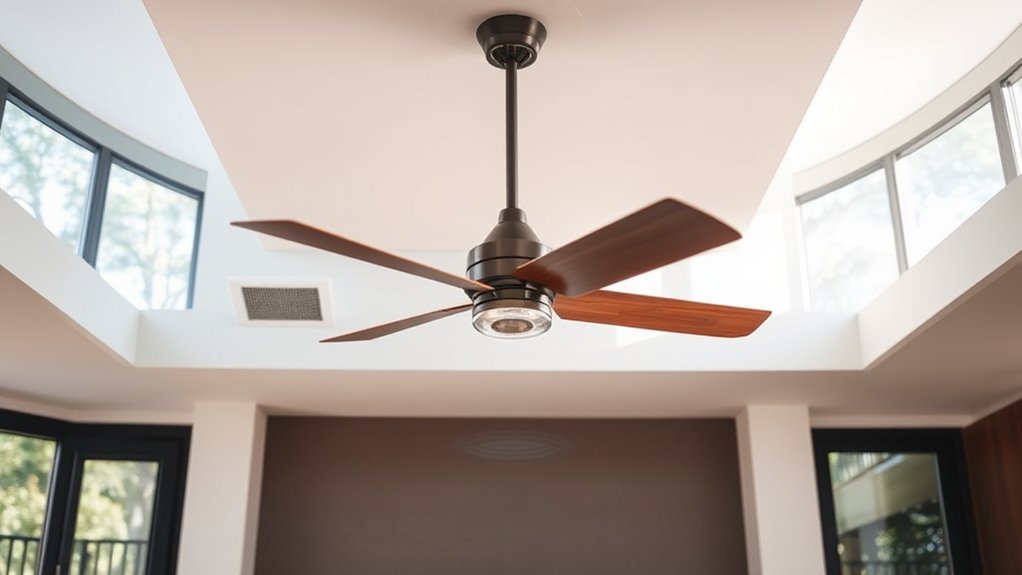
Smart ventilation solutions are transforming indoor air quality by automatically adjusting airflow based on real-time conditions. By integrating air quality monitoring and smart sensors, these systems detect pollutants, humidity, and CO2 levels, then respond accordingly. This technology often combines multiple filtration methods for enhanced effectiveness, ensuring ideal airflow, reducing pollutants and improving comfort. Here are three key benefits:
- Real-time air quality monitoring helps you stay informed about indoor pollutants and triggers ventilation when needed.
- Smart sensor integration allows the system to adapt dynamically, maintaining fresh air without manual intervention.
- Automated airflow adjustments optimize ventilation efficiency, saving energy while keeping indoor air clean.
With these solutions, you gain better control over your environment, ensuring healthier, more comfortable indoor spaces effortlessly.
Seasonal Strategies for Maintaining Optimal Indoor Airflow

Adjusting your indoor airflow strategies to match seasonal changes guarantees your home maintains healthy air quality year-round. Seasonal airflow varies as temperatures shift, so you should modify your ventilation practices accordingly. In winter, use ceiling fans on the reverse setting to circulate warm air near the ceiling, aiding airflow maintenance and reducing cold spots. During summer, set fans to create a breeze that promotes cooling and improves ventilation. Open windows during mild weather to enhance natural airflow and reduce indoor humidity. Seal leaks and check vents before extreme weather hits to prevent drafts and maintain consistent airflow. Incorporating expert voice actors or professional guidance can help you optimize your ventilation setup for better indoor air quality. By tailoring your airflow management to each season, you ensure ideal indoor air circulation, which keeps your air fresh, reduces allergens, and supports overall health throughout the year.
Frequently Asked Questions
How Can I Improve Airflow Without Increasing Energy Costs?
To improve airflow without boosting energy costs, focus on optimizing your ventilation systems and airflow patterns. Use ceiling fans to circulate air efficiently, setting them to rotate counterclockwise in summer and clockwise in winter. Keep vents clear and open, and consider installing adjustable vents to direct airflow where needed. These simple adjustments enhance circulation, reduce indoor air stagnation, and maintain comfort without extra energy consumption.
Are There Specific Ceiling Fan Features That Optimize Air Circulation?
Imagine a quiet revolution in your home’s air flow. Opt for ceiling fans with smart controls; they let you customize speed and timing effortlessly, saving energy. Look for blade designs that promote better airflow, like curved or aerodynamic blades, to maximize circulation without extra effort. These features work together to keep your space comfortable, efficient, and breezy, all while quietly enhancing your indoor air quality.
How Do Indoor Plants Affect Ventilation and Air Quality?
Indoor plants boost ventilation and air quality by improving plant health and promoting air purification. As you care for your plants, they naturally filter toxins and increase humidity, which can enhance overall indoor air quality. Regular watering and proper placement ensure your plants stay healthy, maximizing their air-purifying benefits. Incorporate a variety of plants to create a cleaner, fresher environment, making your home healthier and more inviting.
What Are the Signs of Poor Indoor Air Circulation?
You’ll notice signs of poor indoor air circulation through persistent stuffiness, lingering odors, or dust buildup on surfaces. Headaches, fatigue, or respiratory issues can also signal compromised air quality indicators. Don’t fall for ventilation myths that ventilation alone fixes everything; proper airflow and regular maintenance matter. If these signs appear, improve circulation with fans or open windows, and consider air purifiers to boost overall air quality.
Can DIY Modifications Enhance Ventilation Efficiency Effectively?
Yes, DIY modifications can boost ventilation efficiency by improving airflow patterns. For instance, strategically placing fans or opening windows creates cross-ventilation, effectively reducing stale air. Upgrading or cleaning existing ventilation systems guarantees smoother operation, while adding vents or draft stoppers can optimize airflow. These simple steps make a noticeable difference, helping you maintain fresher indoor air and a healthier environment without costly professional upgrades.
Conclusion
Remember, good indoor air circulation isn’t just about fans and vents—it’s about creating a balanced flow that refreshes your space. Believe it or not, the theory that stagnant air is harmless is a myth; poor circulation can lead to health issues over time. By understanding and applying these tips, you’re not just improving comfort but also protecting your well-being. Embrace the power of airflow, and let your home breathe freely.
